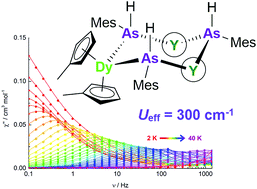Magneto-structural correlations in arsenic- and selenium-ligated dysprosium single-molecule magnets†
Abstract
The structures and magnetic properties of the arsenic- and selenium-ligated dysprosium single-molecule magnets (SMMs) [Cp′3Dy(AsH2Mes)] (3-Dy), [(η5-Cp′2Dy){μ-As(H)Mes}]3 (4-Dy), [Li(thf)4]2[(η5-Cp′2Dy)3(μ3-AsMes)3Li] ([Li(thf)4]2[5-Dy]), and [(η5-Cp′2Dy){μ-SeMes}]3 (6-Dy) are described. The arsenic-ligated complexes 4-Dy and 5-Dy are the first SMMs to feature ligands with metalloid elements as the donor atoms. The arsenide-ligated complex 4-Dy and the selenolate-ligated complex 6-Dy show large anisotropy barriers in the region of 250 cm−1 in zero d.c. field, increasing to 300 cm−1 upon 5% magnetic dilution. Theoretical studies reveal that thermal relaxation in these SMMs occurs via the second-excited Kramers' doublet. In contrast, the arsinidene-ligated SMM 5-Dy gives a much smaller barrier of 23 cm−1, increasing to 35 cm−1 upon dilution. The field-dependence of the magnetization for 4-Dy and 5-Dy at 1.8 K show unusual plateaus around 10 kOe, which is due to the dominance of arsenic-mediated exchange over the dipolar exchange. The effects of the exchange interactions are more pronounced in 5-Dy, which is a consequence of a small but significant increase in the covalent contribution to the predominantly ionic dysprosium-arsenic bonds. Whereas the magnetically non-dilute dysprosium SMMs show only very narrow magnetization versus field hysteresis loops at 1.8 K, the impact of magnetic dilution is dramatic, with butterfly-shaped loops being observed up to 5.4 K in the case of 4-Dy. Our findings suggest that ligands with heavier p-block element donor atoms have considerable potential to be developed more widely for applications in molecular magnetism.


 Please wait while we load your content...
Please wait while we load your content...